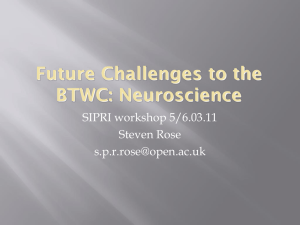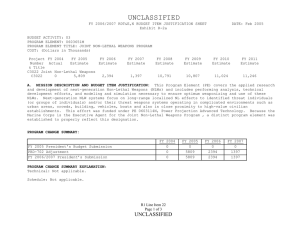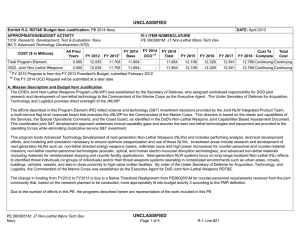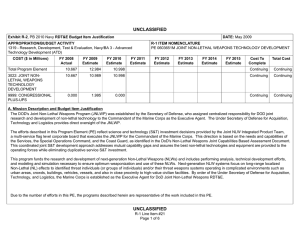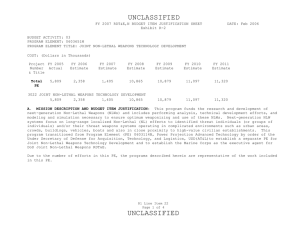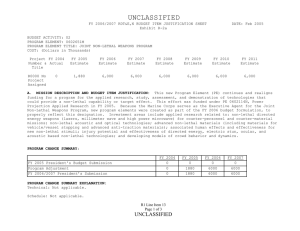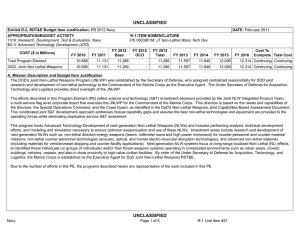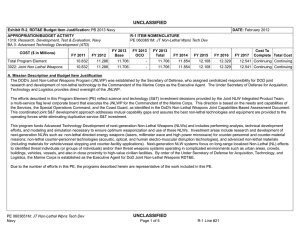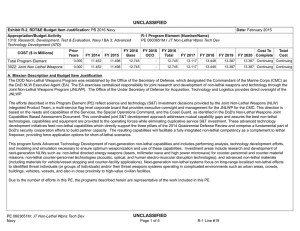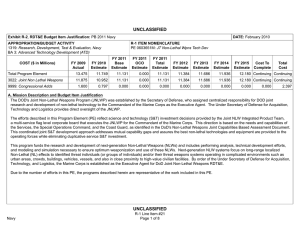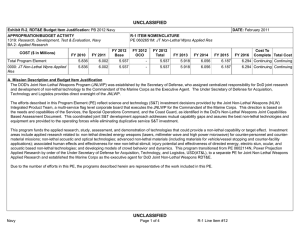UNCLASSIFIED
advertisement
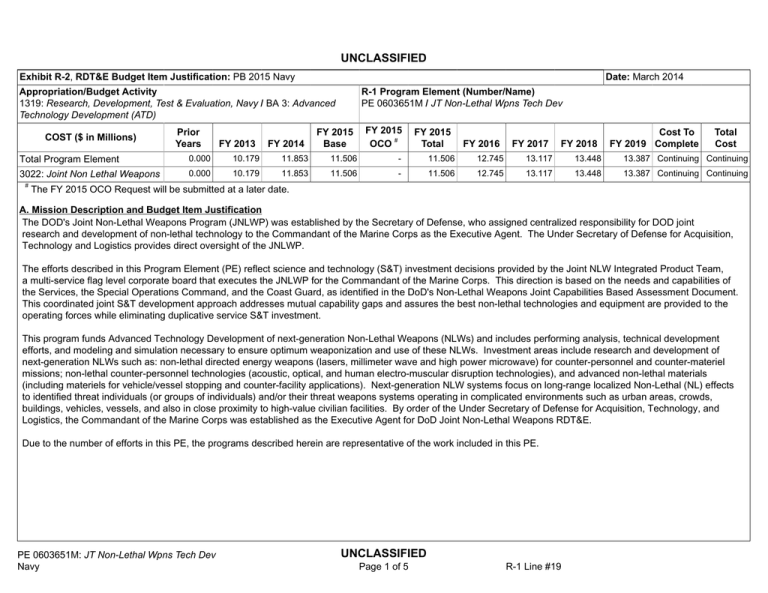
UNCLASSIFIED Date: March 2014 Exhibit R-2, RDT&E Budget Item Justification: PB 2015 Navy Appropriation/Budget Activity 1319: Research, Development, Test & Evaluation, Navy / BA 3: Advanced Technology Development (ATD) COST ($ in Millions) Prior Years FY 2013 FY 2014 R-1 Program Element (Number/Name) PE 0603651M / JT Non-Lethal Wpns Tech Dev FY 2015 Base FY 2015 # OCO FY 2015 Total FY 2016 FY 2017 FY 2018 Cost To FY 2019 Complete Total Cost Total Program Element 0.000 10.179 11.853 11.506 - 11.506 12.745 13.117 13.448 13.387 Continuing Continuing 3022: Joint Non Lethal Weapons 0.000 10.179 11.853 11.506 - 11.506 12.745 13.117 13.448 13.387 Continuing Continuing # The FY 2015 OCO Request will be submitted at a later date. A. Mission Description and Budget Item Justification The DOD's Joint Non-Lethal Weapons Program (JNLWP) was established by the Secretary of Defense, who assigned centralized responsibility for DOD joint research and development of non-lethal technology to the Commandant of the Marine Corps as the Executive Agent. The Under Secretary of Defense for Acquisition, Technology and Logistics provides direct oversight of the JNLWP. The efforts described in this Program Element (PE) reflect science and technology (S&T) investment decisions provided by the Joint NLW Integrated Product Team, a multi-service flag level corporate board that executes the JNLWP for the Commandant of the Marine Corps. This direction is based on the needs and capabilities of the Services, the Special Operations Command, and the Coast Guard, as identified in the DoD's Non-Lethal Weapons Joint Capabilities Based Assessment Document. This coordinated joint S&T development approach addresses mutual capability gaps and assures the best non-lethal technologies and equipment are provided to the operating forces while eliminating duplicative service S&T investment. This program funds Advanced Technology Development of next-generation Non-Lethal Weapons (NLWs) and includes performing analysis, technical development efforts, and modeling and simulation necessary to ensure optimum weaponization and use of these NLWs. Investment areas include research and development of next-generation NLWs such as: non-lethal directed energy weapons (lasers, millimeter wave and high power microwave) for counter-personnel and counter-materiel missions; non-lethal counter-personnel technologies (acoustic, optical, and human electro-muscular disruption technologies), and advanced non-lethal materials (including materiels for vehicle/vessel stopping and counter-facility applications). Next-generation NLW systems focus on long-range localized Non-Lethal (NL) effects to identified threat individuals (or groups of individuals) and/or their threat weapons systems operating in complicated environments such as urban areas, crowds, buildings, vehicles, vessels, and also in close proximity to high-value civilian facilities. By order of the Under Secretary of Defense for Acquisition, Technology, and Logistics, the Commandant of the Marine Corps was established as the Executive Agent for DoD Joint Non-Lethal Weapons RDT&E. Due to the number of efforts in this PE, the programs described herein are representative of the work included in this PE. PE 0603651M: JT Non-Lethal Wpns Tech Dev Navy UNCLASSIFIED Page 1 of 5 R-1 Line #19 UNCLASSIFIED Date: March 2014 Exhibit R-2, RDT&E Budget Item Justification: PB 2015 Navy Appropriation/Budget Activity 1319: Research, Development, Test & Evaluation, Navy / BA 3: Advanced Technology Development (ATD) FY 2013 B. Program Change Summary ($ in Millions) Previous President's Budget Current President's Budget Total Adjustments • Congressional General Reductions • Congressional Directed Reductions • Congressional Rescissions • Congressional Adds • Congressional Directed Transfers • Reprogrammings • SBIR/STTR Transfer • Rate/Misc Adjustments • Congressional General Reductions Adjustments 11.706 10.179 -1.527 - - - - - - -0.448 - -1.079 R-1 Program Element (Number/Name) PE 0603651M / JT Non-Lethal Wpns Tech Dev FY 2014 FY 2015 Base FY 2015 OCO FY 2015 Total 11.854 11.853 -0.001 -0.001 - - - - - - - - 12.108 11.506 -0.602 - - - 12.108 11.506 -0.602 -0.602 - - - -0.602 - Change Summary Explanation Technical: Not applicable. Schedule: Not applicable. PE 0603651M: JT Non-Lethal Wpns Tech Dev Navy UNCLASSIFIED Page 2 of 5 R-1 Line #19 UNCLASSIFIED Date: March 2014 Exhibit R-2A, RDT&E Project Justification: PB 2015 Navy Appropriation/Budget Activity 1319 / 3 COST ($ in Millions) R-1 Program Element (Number/Name) PE 0603651M / JT Non-Lethal Wpns Tech Dev Prior Years 3022: Joint Non Lethal Weapons # FY 2013 - FY 2014 10.179 11.853 FY 2015 Base 11.506 FY 2015 # OCO FY 2015 Total - 11.506 FY 2016 12.745 FY 2017 Project (Number/Name) 3022 / Joint Non Lethal Weapons FY 2018 13.117 13.448 Cost To FY 2019 Complete Total Cost 13.387 Continuing Continuing The FY 2015 OCO Request will be submitted at a later date. A. Mission Description and Budget Item Justification This project funds the research and development of next-generation NLWs and includes performing analysis, technical development efforts, and modeling and simulation necessary to ensure optimum weaponization and use of these NLWs. Investment areas include research and development of next-generation NLWs such as: non-lethal directed energy weapons (lasers, millimeter wave and high power microwave) for counter-personnel and counter-materiel missions; non-lethal counterpersonnel technologies (acoustic, optical, and human electro-muscular disruption technologies), and advanced non-lethal materiels (including materiels for vehicle/ vessel stopping and counter-facility applications). Next-generation NLW systems focus on long-range localized NL effects to identified threat individuals (or groups of individuals) and/or their threat weapons systems operating in complicated environments such as urban areas, crowds, buildings, vehicles, vessels, and also in close proximity to high-value civilian facilities. The increase in the Joint Non-Lethal Weapons funding from FY 2013 to FY 2014 is due to the initiation and expanded evaluation of alternative non-lethal prototype technologies offering operational military utility with the goal of transitioning the best candidates to higher levels of technology development and acquisition. The FY 2014 to FY 2015 decrease in the Joint Non-Lethal Weapons Technology Development PE is due to a funding reduction addressed in Deputy Secretary of Defense Memo, "Strategic Choices and Management Review Resulting Direction and Guidance". This reduction slows the advanced prototype development and demonstration of a smaller, lighter active denial technology demonstrator based on most promising and mature 95 GHZ source technology. It also delays the schedule of the modular prototyping of High Power Microwave (HPM) component hardware and defers initiation of behavior response research and analysis. B. Accomplishments/Planned Programs ($ in Millions) FY 2013 10.179 Title: JOINT NON-LETHAL WEAPONS FY 2013 Accomplishments: - Continued effort to assess the general utility, effect, and effectiveness of technologies for incapacitating personnel, clearing facilities, stopping vehicles and vessels, and denying enemy access to protected areas. - Continued research to define and transition to higher levels of technology development the optimum approaches, technologies and tactics necessary to clear a facility/building with and without entry. - Discontinued current modeling/research to develop an understanding of the complex relationships between individual, group and crowd dynamics in order to predict the macro effects of NLWs. Specifically, investigate factors that cause crowds to move to violent behavior, and what non-lethal technologies will be effective in controlling or mitigating violent crowd behavior. Reevaluating approach. PE 0603651M: JT Non-Lethal Wpns Tech Dev Navy UNCLASSIFIED Page 3 of 5 R-1 Line #19 FY 2014 11.853 FY 2015 11.506 UNCLASSIFIED Date: March 2014 Exhibit R-2A, RDT&E Project Justification: PB 2015 Navy Appropriation/Budget Activity 1319 / 3 R-1 Program Element (Number/Name) PE 0603651M / JT Non-Lethal Wpns Tech Dev Project (Number/Name) 3022 / Joint Non Lethal Weapons B. Accomplishments/Planned Programs ($ in Millions) - Continued effort to examine and optimize non-lethal effects and effectiveness of various non-lethal stimuli, to include light, acoustics, electrical, high power laser, high power microwave and active denial technology. Research includes human effects analysis with respect to existing non-lethal stimuli and other emerging system stimuli to characterize behaviors and their operational relevance. - Continued prototype development and transition to higher levels of technology development of advanced payloads for candidate technological capabilities with applications relevant to emerging capability gaps. - Continued prototype development, demonstration, and transition to higher levels of technology development of the most promising candidate technologies addressing the extended range/duration incapacitation capability gap. - Continued transition to higher levels of development and demonstration for the most promising candidate technologies employing multisensory stimuli. - Continued to address non-lethal counter-personnel capability gaps with alternative directed energy technologies. - Continued transition to higher levels of technology development and demonstrate the most promising directed energy technologies under consideration for counter-personnel and counter-materiel applications. - Continued technology development employing optimized electro-muscular disruption waveforms and mechanisms for an extended duration counter-personnel suppression capability. - Continued advanced prototype development and demonstration of a smaller, lighter active denial technology demonstrator based on most promising and mature 95 GHZ source technology. - Completed integration of the Advanced Total Body Model into a suite of non-lethal effects modeling capability now referred to as the Human Effects Modeling and Analysis Program (HE-MAP) during FY11. Non-lethal effects characterization through modeling and effects testing continues using HE-MAP. - Initiated evaluation of alternative non-lethal prototype technologies offering operational utility and transition best candidates to higher levels of technology development and acquisition. FY 2014 Plans: - Continue all efforts from FY2013, except those noted as completed. - Initiate prototype concepts for an integrated combined effects demonstration platform to provide scalable escalation of force capability using an integrated, systems of systems approach. - Initiate advanced system component research and development for integration into NLE systems (vehicle stopping, vessel stopping, and counter personnel systems). FY 2015 Plans: - Continue all efforts from 2014. - Continue advanced prototype development and demonstration of a smaller, lighter active denial technology demonstrator based on the most promising and mature 95 GHz source technology. PE 0603651M: JT Non-Lethal Wpns Tech Dev Navy UNCLASSIFIED Page 4 of 5 R-1 Line #19 FY 2013 FY 2014 FY 2015 UNCLASSIFIED Date: March 2014 Exhibit R-2A, RDT&E Project Justification: PB 2015 Navy Appropriation/Budget Activity 1319 / 3 R-1 Program Element (Number/Name) PE 0603651M / JT Non-Lethal Wpns Tech Dev Project (Number/Name) 3022 / Joint Non Lethal Weapons B. Accomplishments/Planned Programs ($ in Millions) - Continue incorporation of suitable sensors capable of measuring NL stimuli into surrogate test models as part of the Human Effects Modeling Analysis Program (HEMAP). - Initiate modular prototyping of High Power Microwave (HPM) component hardware meeting development objectives for subsequent integration into an HPM-capable system configuration. Accomplishments/Planned Programs Subtotals FY 2013 10.179 FY 2014 11.853 FY 2015 11.506 C. Other Program Funding Summary ($ in Millions) N/A Remarks D. Acquisition Strategy N/A E. Performance Metrics The primary objective of this Program Element is the development of technologies that lead to the next-generation of Non-Lethal Weapons which address identified and prioritized joint NLW capability gaps. The program consists of a collection of projects for the development and evaluation of feasibility demonstration models. Individual project metrics reflect the technical goals of each specific project. Typical metrics include both the effectiveness of the technology, human effects and effectiveness, mitigation of high priority joint NLW capability gaps, and potential for compliance with policy and legislation. Overarching considerations include the advancement of related Technology Readiness Levels and Human Effects Readiness Levels, the degree to which project investments are leveraged with other performers, reduction in life cycle cost upon application of the technology, and the identification of opportunities to transition technology to higher categories of development. PE 0603651M: JT Non-Lethal Wpns Tech Dev Navy UNCLASSIFIED Page 5 of 5 R-1 Line #19
